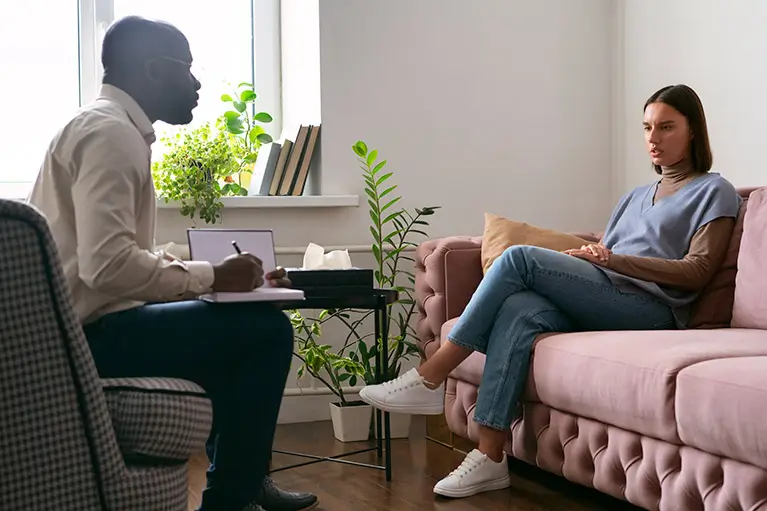Key Takeaways
- A supportive ketamine therapy environment enhances patient comfort and treatment efficacy.
- Comfortable seating, soothing lighting, and a quiet space are essential for a therapeutic setting.
- Engaging the senses with sound and aromatherapy can improve the healing experience.
- Professional presence and patient safety measures are non-negotiable during treatment.
- Post-treatment support, including integration and follow-up, is crucial for long-term benefits.
When it comes to healing, the space around us can be just as influential as the treatment itself. That’s why creating a supportive environment for ketamine therapy isn’t just about aesthetics; it’s about crafting a sanctuary that speaks to comfort, safety, and tranquility. It’s about making a space where healing isn’t just possible – it’s encouraged.
Setting the Stage for Healing: Building a Supportive Ketamine Space
Let’s start by painting a picture of the ideal therapy space. Imagine walking into a room that feels like a warm embrace. The lighting is soft, the air carries a hint of lavender, and the chair you’re about to sit in looks so inviting you can’t wait to sink into it. This is the kind of environment we’re aiming to create for those embarking on a journey with ketamine therapy.
Why Ambiance Matters for Ketamine Treatment
It’s not just about comfort; it’s about setting the stage for the mind to open and the body to relax. The ambiance of a room can greatly influence a person’s state of mind and ability to be receptive to treatment. Because ketamine works not just on the body but also on the mind, the environment can either be a gateway or a barrier to the healing process.
Core Elements of a Therapeutic Space
A supportive ketamine therapy environment is built on several core elements:
- Physical comfort to ease the body into a state of relaxation.
- Ambient lighting that calms the mind and sets a peaceful mood.
- A soundscape that envelops the senses and promotes a meditative state.
- A scent that soothes and reminds one of a safe space.
Now, let’s dive into the details and explore how each element contributes to a healing atmosphere.
Comfort Is Key
The first step in creating a supportive environment is ensuring physical comfort. This means selecting chairs or couches that not only look inviting but provide the kind of support and comfort that help patients feel secure and at ease. It’s also important to consider the overall atmosphere of the space, which can be enhanced through innovative group therapy activities designed for relaxation and engagement.
Selecting the Right Furniture
Choosing the right furniture is crucial. You want pieces that offer enough support to keep the patient’s body from straining, yet are soft enough to feel like a gentle hug. Ergonomics play a big role here – the furniture should cater to a relaxed posture, enabling the patient to surrender to the experience without distraction.
Creating a Soothing Atmosphere with Lighting and Decor
Besides that, the lighting should be dimmable, allowing for adjustments to suit individual preferences. Soft, warm tones often work best to create a serene backdrop for therapy. Decor, too, should be minimalistic and calming, with natural elements like plants or water features that subtly remind one of life’s simple beauties.
Engaging the Senses
Engaging the senses can help deepen the therapeutic experience. By crafting a multisensory environment, we cater to the whole person, not just their condition.
Crafting a Custom Sound Environment
Sound can have a profound effect on our state of mind. In a ketamine therapy setting, it’s essential to have a sound environment that can be tailored to the individual. Whether it’s the gentle hum of nature sounds or the soft cadence of ambient music, the right auditory backdrop can enhance the therapeutic journey.
Most importantly, the volume should be controlled to ensure it’s present but not overwhelming, allowing the patient to drift into their thoughts without interruption.
Integrating Aromatherapy
Aromatherapy is another powerful tool. Scents like lavender or chamomile can have a calming effect, making them ideal for a therapy setting. By diffusing essential oils or using scented candles, we can create an olfactory experience that not only relaxes the mind but can also evoke positive memories and emotions, aiding in the therapeutic process.

In the next section, we will delve into the importance of patient safety, the role of the treatment team, and the ways to build trust with patients to create a supportive ketamine treatment environment.
Patient Safety and Support
When a patient steps into the treatment space, their well-being becomes the utmost priority. Ensuring safety during ketamine therapy is critical, not just for the patient’s peace of mind, but also for the efficacy of the treatment.
Professional Presence During Treatment
Throughout the ketamine infusion, a trained professional should always be present. This person is there to monitor the patient’s physical and emotional state, offer reassurance, and provide immediate assistance if needed. The presence of a compassionate caregiver can make all the difference in creating a supportive environment.
Monitoring Patient Vital Signs
Close monitoring of vital signs is another key aspect of patient safety. Equipment to track heart rate, blood pressure, and oxygen saturation should be used to ensure the patient’s physical state remains stable throughout the session. This monitoring provides a safety net that allows both the patient and the caregiver to relax into the experience.
The Role of the Treatment Team
The treatment team plays a pivotal role in shaping the patient’s experience. From the moment a patient walks in, the team is responsible for setting the tone of the treatment and providing a supportive atmosphere.
Patient Intake: Setting Expectations and Intentions
During patient intake, clear communication about what to expect can help ease anxiety. It’s also the perfect time to help patients set intentions for their journey. This could be as simple as a desire to find peace or as complex as reconciling past trauma. These intentions can guide the therapeutic process and give the patient a sense of purpose.
Supporting Patients Through Their Journey
Support doesn’t end when the infusion begins. Throughout the treatment, the team should be attentive to the patient’s needs, offering words of encouragement or simply being present. After the session, discussing the experience and any insights gained can help patients process and integrate their journey into their ongoing healing process.
Building Trust with Patients
Trust is the foundation of any therapeutic relationship. In a ketamine therapy setting, where patients may feel vulnerable, building trust is especially important.
Communication Practices That Show Care
Effective communication is key to building trust. This means listening actively, speaking with empathy, and ensuring that the patient feels heard and understood. It’s also important to provide clear information about the treatment process and answer any questions with patience and care.
For example, if a patient expresses concern about the sensation of disassociation that can occur during ketamine therapy, a caregiver might say, “It’s common to feel a sense of separation from your usual state of consciousness during treatment. Remember, I’m here with you, and this feeling is part of the healing process.”
Maintaining Professional Boundaries
While it’s important to show care and empathy, maintaining professional boundaries is also crucial. This ensures that the relationship stays therapeutic and focused on the patient’s healing journey.
The Importance of Post-Treatment Environment
The environment a patient returns to after treatment can significantly impact their ability to integrate the experience. A supportive post-treatment environment is one that continues to offer safety, tranquility, and understanding. Learn more about mental health group activities that can foster such an environment.
Guiding Patients Through Integration
Integration is the process of making sense of the ketamine experience and incorporating any insights into daily life. Guidance from the treatment team can include discussions, therapy sessions, or recommended practices like journaling or meditation to support this process.
Creating a Follow-Up Plan
A follow-up plan ensures that patients continue to feel supported after they leave the clinic. This might include scheduled check-ins, access to resources, or connections to community support groups. It’s about extending the care beyond the walls of the treatment room and into the patient’s life.
In conclusion, a supportive ketamine therapy environment is a holistic concept that encompasses the physical space, the treatment team’s approach, and the follow-up care. By focusing on these elements, we can provide a truly healing experience for those seeking relief through ketamine therapy.
Supportive (Spravato) Ketamine Treatment Environment at Calusa Recovery
Spravato, a brand-name prescription nasal spray, stands out as the sole medication of its kind approved in the U.S. for potentially treating treatment-resistant depression, with esketamine as its generic name.
At Calusa Recovery, we have incorporated Spravato into our comprehensive range of treatments for depression in individuals with substance use issues.
Contact us today to learn how we can integrate our supportive ketamine treatment environment into your cutting-edge substance use disorder treatment plan.
Frequently Asked Questions
The following are some frequently asked questions about ketamine therapy environments and some practical advice for those interested in this treatment modality.
1. Why is setting important in ketamine therapy?
Setting is vital in ketamine therapy because the environment can significantly influence a patient’s comfort level, anxiety, and overall experience. A well-crafted setting can promote relaxation, enhance the treatment’s effectiveness, and help patients feel safe as they explore their inner thoughts and emotions during the therapy session.
2. How can music influence the ketamine treatment experience?
Music can profoundly impact the ketamine treatment experience by providing a soothing backdrop that can help guide the patient’s journey. The right music can evoke emotions, help in relaxation, and even alter the perception of time, which can be particularly beneficial during a session that may otherwise feel disorienting.
3. What safety measures are crucial during ketamine treatment?
Safety measures during ketamine treatment include continuous monitoring of vital signs, having a trained professional present at all times, and creating a physical environment that is free of hazards. These measures ensure that any medical needs can be addressed promptly and that the patient’s physical and psychological well-being is safeguarded.
4. How does intention setting impact the outcome of ketamine therapy?
Intention setting can help focus the patient’s mind and create a sense of purpose for the therapy session. By establishing clear intentions, patients may find it easier to manage their experience and connect their therapy to specific personal goals or areas of healing, which can lead to more meaningful outcomes.
5. What kind of post-treatment support is beneficial for patients?
Post-treatment support that benefits patients includes follow-up appointments, integration therapy, and access to resources such as support groups or wellness activities. This support can help patients process their experiences, apply insights gained during therapy, and maintain progress in their healing journey.
For instance, a patient who has undergone ketamine therapy may benefit from a follow-up call where they can discuss their experience and feelings with a therapist. This can be an opportunity to reflect on any insights gained and to develop strategies for integrating these insights into daily life.










